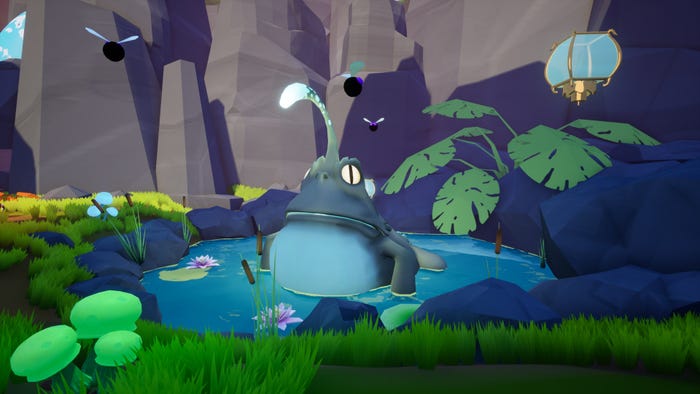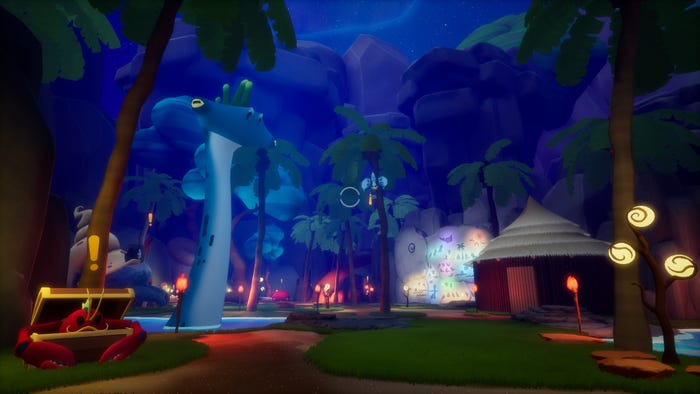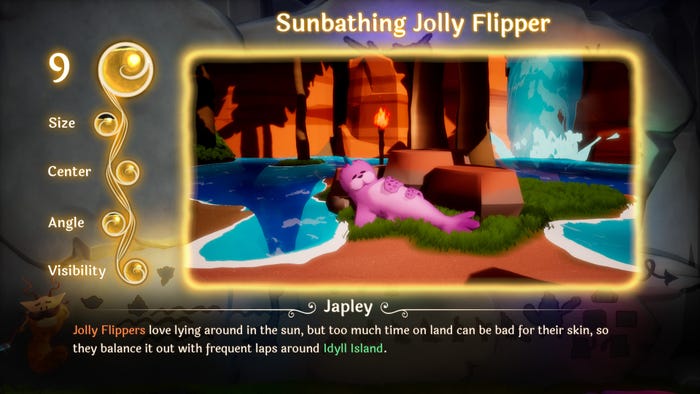Trending
Opinion: How will Project 2025 impact game developers?
The Heritage Foundation's manifesto for the possible next administration could do great harm to many, including large portions of the game development community.

| Picture Perfect: Exploring Photography Games | ||
| Every day this week, Game Developer is serving up a gallery of interviews, deep dives, and more digging into the evolution of Photography in video games. | ||
| Browse Latest Articles | Submit your Blog | |
This Pokémon Snap-inspired game uses robust photo editing tools to create an expressive space for players.

If you want to snap pictures of interesting creatures in unique poses in Alekon, you'll need to solve play minigames, throw parties, and tell ghost stories—whatever it takes to get that special picture.
Game Developer sat down with Kevin Notar, one of the designers and writers for the project, to talk about the importance of the creatures' personalities and how they shaped the game, how they added many possibilities to the photography through both the on-rails or free roam experience, and how they focused on letting players be creative with their photo editing tools.
Game Developer: Alekon sees players taking pictures of charming creatures inspired by concepts (called Fictions). What inspired this idea for a photography game?
Notar: When I first started Alekon, I was working on a AAA project that was going through a variety of ups and downs. There were too many meetings, which prevented progress. Alekon became a creative outlet for me on the weekends. I started writing a game design document that had info about level designs, the creatures that inhabited them, the overall aesthetic, etc.
The game's focus on photography was the result of ideas I had about the setting. I wanted to explore dreams and the subconscious and thought that photography could work well with this. I was intrigued by the potential of a game that lets players explore their subconscious and then uses photography to bring those hidden elements into their conscious mind. It seemed novel, and not to mention, I was a huge Pokémon Snap fan growing up.
This lore foundation was inspiring, and even though it's buried really deep in the final game, you'll find it woven throughout various dialogues.
In the early game design document, the levels were much wilder. I had a jazz emporium level where all of the creatures played instruments, a junkyard level where all of humanity's lost ideas were thrown into, etc. The levels were wacky and Fictional, so I called their inhabitants Fictions. The scope for the levels was too high, but the Fictions and overall vision remained.

Image via The Alekon Company.
Can you tell us a bit about the process of designing a Fiction? How did you pick concepts to make into creatures, and how did you take those concepts and give them physical animal shapes?
Early on, Skylar Surra was helping out with concept art. I'd give both him and Daniel Kraft the Fiction design, their quests, what the Fictions were going to do, the landscape they would be in, etc. They would then handle the details.
Eventually, Daniel Kraft took over the concept as well and started making pieces of the Fictions modular, copying elements between them. This sped up our process greatly.
What drew you to the game's playful art style? Why choose this visual style for your unique creatures and world?
Limitations! Many of our art assets are from a variety of online asset stores. We didn't have a dedicated artist, so the levels fell on me to "art" up. I relied on lighting for cohesion, which I learned by watching a lot of Udemy tutorials.
The other benefit of our visual style is performance. By keeping the poly count low, we could focus more on making the game fun and less on constantly optimizing it.
The Fictions do a variety of poses so long as the player solves puzzles in the environment. What thoughts went into creating the various actions and poses some of the creatures do?
We tried to bring their personalities out on the map with their poses, interactions, sounds, etc. The Fictions don't care about the puzzles themselves; they just care about the outcome. For example, Mudwog doesn't care that we moved the lanterns closer to him to attract the bugs. He just wants the bugs. If you give Mudwog bugs, then it's a great opportunity for more poses to take pictures of.
Interacting with Fictions on Dream's Doorstep is our biggest differentiator since it allows you to speak with them and understand their quirks and habits. For example, Mudwog has no ego, but Wullard does! If you throw a donut at Mudwog, he doesn't care, but throwing a donut at Wullard will make him mad enough to smash into a rock, open a new path, and get a new pose for you to take a picture of.

Image via The Alekon Company.
Likewise, what thoughts went into the environmental puzzles players could solve? How did you shape puzzles so they fit into the natural environments of Alekon?
Early on, Jay Watford and I figured out tools that would give us a variety of mechanics to play with. Jason Burton then helped to make these mechanics look and feel good from an art and VFX perspective. From there, I'd mark out puzzle areas on the levels and revisit them throughout development, adding more where applicable.
Most of the time, it would be looking at the environment feature and thinking, "Hmm... I bet we could add a magnet puzzle here" or something along those lines. I'd then work it into the level to fit it in the best I could. For example, adding more rocks around if it was a magnet, trying to find dark places for the lanterns, etc.
Friendship is an important element alongside photography in this game. What appealed to you about letting players befriend the Fictions?
It's just more fun to talk with characters than insentient creatures. It gives us more to work with in terms of minigames, quests, and IP. If the Fictions were similar to wild animals and didn't appreciate the things you did for them, it wouldn't be as satisfying. Imagine if all of the Fiction dialogue was "roar" or "grrr." This might be funny for a second, but it gets old quickly. When you get to know the oddities of Fictions, their wants, their history, etc., helping them becomes a much greater reward.
What thoughts went into creating the minigames you play to become friends with the Fictions? What do you feel the minigames, as well as friendships, added to this photo-taking experience?
This was all Max Shawabkeh. When Max joined, it unlocked a whole world of possibility for Alekon. He's a truly exceptional engineer and can really do it all.
When Max suggested we could have minigames on Dream's Doorstep instead of simply talking to them, I lit up. It was a great way to add depth to the game, giving players many more ways to engage with Fictions and get to know them in a way that simple text never could.
I think that the minigames are one of the most quintessential pieces of Alekon. Without them, we wouldn't have Jo'keel's Comedy Club or Justaplant's Court Case. These quests, while optional, show Fictions in a special light and imprint lasting memories. It makes you want to go back into the level and get the best picture you can of that Fiction.

Image via The Alekon Company.
Alekon grades players based on their picture. How did you choose the criteria by which to grade the picture? What sort of work went into programming the game to be able to score the players on how well they did?
Our goals for this were:
Easy to understand and objective.
Not trivial, so we could make some Fictions and poses more challenging to photograph than others.
Not so specific that the players couldn't express their creativity.
According to Max, the coding itself was straightforward. It was designing the criteria and tweaking the difficulty that took time. We referenced all other photography games out there but landed on our ranking system since it made the most sense for the game.
Players can freely roam the game or explore it on-rails. What drew you to have these two systems? What challenges or benefits did you face in letting players be able to do both?
While we were playtesting early on, we felt that the game needed more than just an on-rails experience. Exploring on foot gave it a totally different feel. Players could take their time, set up the perfect shot, interact with more of the level, etc. The gameplay possibilities opened up. What's also nice is that the on-rails gameplay tours you around the level and familiarizes you with it before you unlock free roam.
However, free roam did take a lot of work. I had to add many more meshes to prevent the player from escaping the level, make sure that the surfaces all felt good to traverse upon, add more exclusive things that you could only do while free-roaming, etc.
We also had different rules for on-rails vs free roam, such as what happens when you jump on a Fiction while in free roam, what happens when you pass through one while on rails, etc. The work was worth it, though.
Players have some ability to get creative with edits and certain toys. How did you decide on the tools players would have to jazz up their photos? How did you implement abilities that would make the pictures more interesting or fun?
Creativity is a pillar for Alekon and we constantly tried to work it into the game.
We had a lot of Google sheets with our ideas for minigames, quest rewards, etc. Most of the time, we came up with the idea, wrote it on the spreadsheet, and then iterated on it from there. If it seemed like something that would allow expression and be fun to interact with, we then assigned it as a reward to one of the Fictions based on their personality.
One of the most gratifying elements is seeing how other players use these tools. We have a small Discord where people have posted their favorite photos, their Dream's Doorstep decorations, etc. Everyone adds a different twist to it, and many have been inspired by the game. We've had a person cry during the ending of Alekon while streaming, a person who created an entire wiki for the game by himself, and even a person who is now incorporating Alekon Fictions into his own indie game titled Abomi Nation: Monster Rifts.
Ultimately, our goal was to empower players with creative tools that not only enhance their in-game experience but also inspire them to express themselves and connect with others in ways that extend far beyond the game itself.
You May Also Like